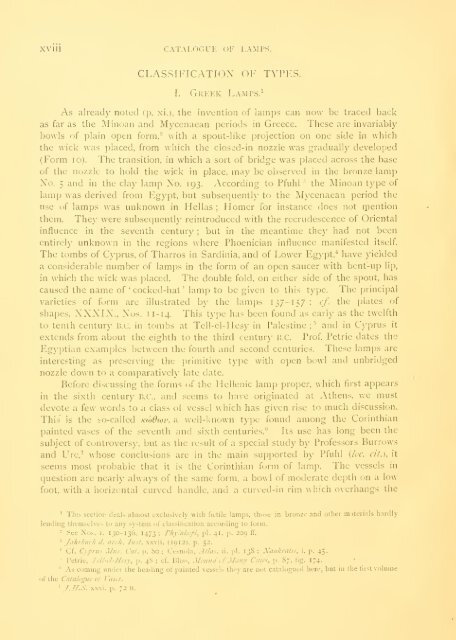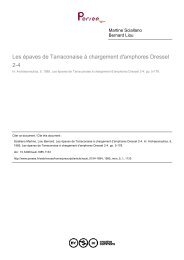Catalogue of the Greek and Roman lamps in the British museum
Catalogue of the Greek and Roman lamps in the British museum
Catalogue of the Greek and Roman lamps in the British museum
Create successful ePaper yourself
Turn your PDF publications into a flip-book with our unique Google optimized e-Paper software.
XVIU CATALOGUE OF LAMPS.<br />
CLASSIFICATION OF TYPFS.<br />
I. <strong>Greek</strong> Lamps.'<br />
As .already noted (p. xi.), <strong>the</strong> <strong>in</strong>vention <strong>of</strong> <strong>lamps</strong> can now be traced back<br />
as far as <strong>the</strong> M<strong>in</strong>oan <strong>and</strong> Mycenaean periods <strong>in</strong> Greece. These are <strong>in</strong>variably<br />
bowls <strong>of</strong> pla<strong>in</strong> open form,'- with a spout-like projection on one side <strong>in</strong> which<br />
<strong>the</strong> wick was placed, from which <strong>the</strong> clossd-<strong>in</strong> nozzle was gradually developed<br />
(Form lo). The transition, <strong>in</strong> which a sort <strong>of</strong> bridge was placed across <strong>the</strong> base<br />
<strong>of</strong> <strong>the</strong> nozzle to hold <strong>the</strong> wick <strong>in</strong> place, may be observed <strong>in</strong> <strong>the</strong> bronze lamp<br />
No. 5 <strong>and</strong> <strong>in</strong> <strong>the</strong> clay lamp No. 193. Accord<strong>in</strong>g to Pfuhl ' <strong>the</strong> M<strong>in</strong>oan type <strong>of</strong><br />
lamp was derived from Egypt, but subsequently to <strong>the</strong> Mycenaean period <strong>the</strong><br />
use <strong>of</strong> <strong>lamps</strong> was unknown <strong>in</strong> Hellas ; Homer for <strong>in</strong>stance does not ipention<br />
<strong>the</strong>m. The\- were subsequentl}^ re<strong>in</strong>troduced with <strong>the</strong> recrudescence <strong>of</strong> Oriental<br />
<strong>in</strong>fluence <strong>in</strong> <strong>the</strong> seventh century ; but <strong>in</strong> <strong>the</strong> meantime <strong>the</strong>y had not been<br />
entirely unknown <strong>in</strong> <strong>the</strong> regions where Phoenician <strong>in</strong>fluence manifested itself<br />
The tombs <strong>of</strong> Cyprus, <strong>of</strong> Tharros <strong>in</strong> Sard<strong>in</strong>ia, <strong>and</strong> <strong>of</strong> Lower Egypt,' have yielded<br />
a considerable number <strong>of</strong> <strong>lamps</strong> <strong>in</strong> <strong>the</strong> form <strong>of</strong> an open saucer with bent-up lip,<br />
<strong>in</strong> which <strong>the</strong> wick was placed. The double fold, on ei<strong>the</strong>r side <strong>of</strong> <strong>the</strong> spout, has<br />
caused <strong>the</strong> name <strong>of</strong> ' cocked-hat ' lamp to be given to this type. The pr<strong>in</strong>cipal<br />
varieties <strong>of</strong> form arc illustrated by <strong>the</strong> <strong>lamps</strong> 137-157 ;<br />
cf. <strong>the</strong> plates <strong>of</strong><br />
shapes, XXXIX., Nos. 11-14. This type has been found as early as <strong>the</strong> twelfth<br />
to tenth century B.C. <strong>in</strong> tombs at Tell-el-IIesy <strong>in</strong> Palest<strong>in</strong>e ;''' <strong>and</strong> <strong>in</strong> Cyprus it<br />
extends from about <strong>the</strong> eighth to <strong>the</strong> third century L.C. Pr<strong>of</strong> Petrie dates <strong>the</strong><br />
Egyptian examples between <strong>the</strong> fourth <strong>and</strong> second centuries. These <strong>lamps</strong> are<br />
<strong>in</strong>terest<strong>in</strong>g as preserv<strong>in</strong>g <strong>the</strong> primitive type with open bowl <strong>and</strong> unbridged<br />
nozzle down to a comparatively late date.<br />
Before discuss<strong>in</strong>g <strong>the</strong> forms <strong>of</strong> <strong>the</strong> Hellenic lamp proper, which first appears<br />
<strong>in</strong> <strong>the</strong> sixth century B.C., <strong>and</strong> seems to have orig<strong>in</strong>ated at A<strong>the</strong>ns, we must<br />
devote a few words to a class <strong>of</strong> vessel which has given rise to much di.scussion.<br />
This" is <strong>the</strong> so-called kcoOcop, a well-known type found among <strong>the</strong> Cor<strong>in</strong>thian<br />
pa<strong>in</strong>ted vases <strong>of</strong> <strong>the</strong> seventh <strong>and</strong> sixth centuries.*^ Its use has long been <strong>the</strong><br />
subject <strong>of</strong> controversy, but as <strong>the</strong> result <strong>of</strong> a special study by Pr<strong>of</strong>essors Burrows<br />
<strong>and</strong> Ure,' whose conclusions are <strong>in</strong> <strong>the</strong> ma<strong>in</strong> supported by Pfuhl {/oc. at.), it<br />
seems most probable that it is <strong>the</strong> Cor<strong>in</strong>thian form <strong>of</strong> lamp. The vessels <strong>in</strong><br />
question are nearly always <strong>of</strong> <strong>the</strong> same form, a bowl <strong>of</strong> moderate depth on a low<br />
foot, with a horizontal curved h<strong>and</strong>le, <strong>and</strong> a curved-<strong>in</strong> rim which overhangs <strong>the</strong><br />
' This secliop deals almost exclusively wilh fictile <strong>lamps</strong>, those <strong>in</strong> bronze <strong>and</strong> o<strong>the</strong>r m.iterials hardly<br />
lend<strong>in</strong>g <strong>the</strong>mselves to any system <strong>of</strong> classification accord<strong>in</strong>g to form.<br />
See Nos. I, 130-136, 1473 ; Phylakopi, pi. 41, p. 209 ff.<br />
^ Jahrbuch d. arch. Inst, xxvii. (1912), p. 52.<br />
* Cf. Cyprus Mus. Cat. \>. 80; Cesnola, Atlas, ii. pi. 13S ; Naiikratis, i. p. 45.<br />
' Petrie, Tcll-cl-Hesy, p. 48 ; cf. Bli.ss, Mound <strong>of</strong> Many Citu-s, p. 87, lig. 174.<br />
' As com<strong>in</strong>g under <strong>the</strong> head<strong>in</strong>g <strong>of</strong> pa<strong>in</strong>ted vessels <strong>the</strong>y are not catalogued here, but <strong>in</strong> <strong>the</strong> tirst volume<br />
<strong>of</strong> <strong>the</strong> <strong>Catalogue</strong> <strong>of</strong> I 'asis.<br />
' J.H.S. xxxi. p. 72 \i.




